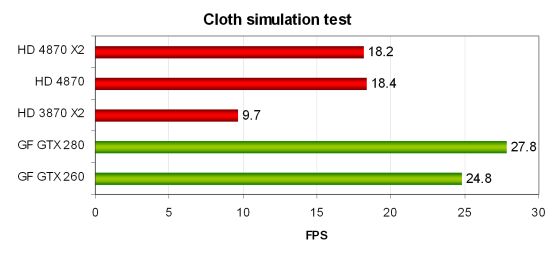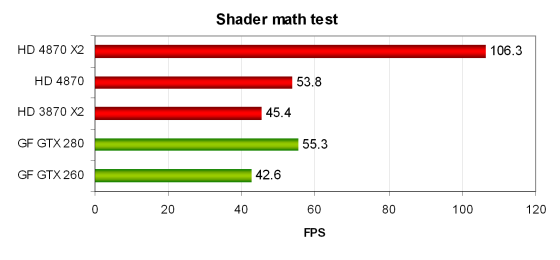 |
||
|
||
| ||
3DMark Vantage: Feature TestsWe again added synthetic tests from 3DMark Vantage into this review. It's a new benchmark with interesting feature tests, which differ from ours. Perhaps, we'll draw some new useful conclusions from the analysis of cards' results in this benchmark. Feature Test 1: Texture Fill The first test deals with texture fill rate. It fills a rectangle with values read from a small texture with many texture coordinates, which are changed in each frame.  Correlation of cards' results is similar to what we see in our tests, when we use conditions, where NVIDIA cards do not get an additional advantage from many TMUs. The old dual-GPU card from AMD goes on a par with the new single-GPU solution. And HD 4870 X2 significantly outperforms all solutions from NVIDIA and AMD. It fully complies with the theory, because RV770 features highly efficient texture units, and AFR effectively doubles FPS in texturing tests. Feature Test 2: Color Fill It uses a simple pixel shader, which does not limit performance. An interpolated color value is written into the off-screen buffer (render target) with alpha blending. It uses a 16-bit off-screen buffer of the FP16 format, which is often used in games employing HDR, so this is a timely test.  Results of this test agree with our synthetic tests, taking into account that we use an integer buffer with 8 bits per component, while the Vantage test employs a floating-point 16-bit buffer. So its results are twice as low. These numbers reflect memory bandwidth (multiplied by two for dual-GPU cards) rather than ROP performance. Results agree with theoretical data, and depend mostly on memory bus width and its clock rate. In this test the new HD 4870 demonstrates high results, benefiting from its improved ROPs and high GDDR5 memory bandwidth. It performs a tad better than HD 3870 X2 and GTX 260 with a 448-bit memory bus. And the new dual-GPU card doubles this result, keeping the title of the absolute leader in our tests. Feature Test 3: Parallax Occlusion Mapping It's one of the most interesting feature tests, as this technique is already used in games. It draws one quadrangle (to be more exact, two triangles) using Parallax Occlusion Mapping that imitates complex geometry. The test uses resource-intensive operations to trace rays and high-res Z maps. This surface is also shaded using the heavy Strauss algorithm. This test uses a very complex and heavy pixel shader with multiple texture lookups during ray tracing, dynamic branches, and complex Strauss lighting algorithms.  This test depends on shader power, branching efficiency, and texture fetch rate combined. That is, it takes a balanced GPU and card to reach high speed. Efficiency of executing branches in shaders is of primary importance, so called execution granularity. The old cards from both manufacturers are always outperformed in this test, so HD 3870 X2 is slower than HD 4870. CrossFire rendering is very effective in this test. Results of RADEON HD 4870 X2 are twice as high as those of HD 4870, so the new card outperforms even GeForce GTX 280. Even though AMD solutions usually scored better in texture fetch and arithmetic tests, the difference between top GeForces and RADEONs in this POM test is less than 30%. Feature Test 4: GPU Cloth This test computes physical interactions (cloth simulation) using a GPU. It uses vertex simulation with the help of vertex and geometry shaders, with several passes. Stream out is used to move vertices from one pass to the other. Thus, this feature test benchmarks execution of vertex and geometry shaders, and stream out speed.  This test does not favor dual-GPU cards. HD 3870 X2 demonstrates very low results (not higher than a single-GPU solution in our previous tests), and HD 4870 X2 is also weak here, even a tad slower than HD 4870. So, AMD cards lag behind in this test again. Even the dual-GPU HD 4870 X2 card is way below GeForce GTX 260, to say nothing of GTX 280. It looks that performance in GPU Cloth does not depend on shaders, but on stream out. Besides, GPUs do not interact efficiently in this case. No sideport can help here. Feature Test 5: GPU Particles Physics simulation test based on particle systems computed with the help of GPUs. The test also uses vertex simulation, where each vertex is a single particle. Stream out is used for the same purpose as in the previous test. The test computes hundreds of thousands of particles, all of them being animated separately, and their collisions with a bump map. Similar to one of our tests in RightMark3D 2.0, particles are drawn with a geometry shader, which creates four vertices from each point and forms a particle from them. However, the heaviest load falls on shader units (vertex calculations), stream out is used as well.  The situation is similar to the previous case, only the new RV770-based cards perform much better. These AMD cards have gone up, but GeForce GTX 280 is still the leader. Other cards are close to it, but they are slower. The new dual-GPU card from AMD again performs close to the single-GPU modification, so we suspect bad compatibility of another algorithm with multi-GPU rendering. Feature Test 6: Perlin Noise This feature test is arithmetically intensive for a GPU. It calculates several octaves of Perlin noise in a pixel shader. Each color channel uses its own noise function for higher GPU loads. Perlin noise is a standard algorithm, which is often used for procedural texturing, it's a mathematically complex procedure.  And the last feature test in Vantage shows pure arithmetic performance of GPUs. No wonder its performance generally agrees with what we have seen above in our arithmetic tests from RightMark 2.0, although HD 4870 and GTX 280 perform almost on a par here. On the whole, AMD cards naturally outperform NVIDIA cards. And RADEON HD 4870 X2 is a pure leader, being exactly twice as fast as its single-GPU modification. Conclusions on the synthetic testsSo, results of synthetic tests confirm our conclusions made in previous articles. The new GPU from AMD is very good. RV770 features a lot of changes, so even the single-GPU solution is one of the leaders almost in all synthetic tests. And RADEON HD 4870 X2 outperforms its closest competitor, GeForce GTX 280, almost in all tests owing to the improved architecture of RV770, which had its main problems fixed. The new solution based on two GPUs is very powerful, it contains a lot of execution units, and it supports GDDR5 memory of sufficient volume (more memory is available per chip than in the single-GPU model). AMD has fixed some bugs in its drivers, and now HD 4870 X2 is certainly one of the fastest graphics cards (don't forget about two GPUs and AFR, of course) in our synthetic tests. The only questions we've got concern lower efficiency of executing branches in shaders, which affects performance of parallax mapping algorithms, and the speed of stream out, because of which new solutions from AMD are outperformed by competing solutions from NVIDIA in a couple of tests. In return, the graphics card under review offers unsurpassed computing power. The next part of our article contains tests of the new dual-RV770 solution from AMD and other cards from both manufacturers in several modern games. The results must confirm our conclusions. We assume that HD 4870 X2 will be faster than all its competitors in most cases. Except for situations with AFR non-operability and algorithms, which are ill-compatible with multi-GPU rendering. Write a comment below. No registration needed!
|
Platform · Video · Multimedia · Mobile · Other || About us & Privacy policy · Twitter · Facebook Copyright © Byrds Research & Publishing, Ltd., 1997–2011. All rights reserved. |